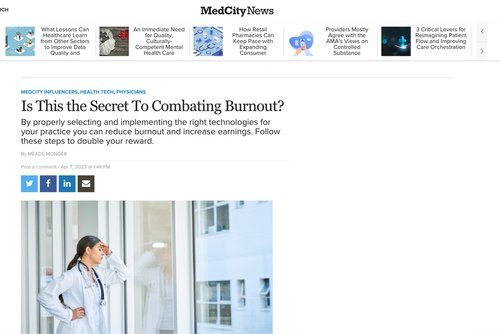Price Transparency Reveals Multiple Dimensions of Healthcare Inequities Beyond Just Patients
Price transparency - the much-discussed US regulations that became federal law in 2019 - has taken time to implement, but its significant side effects are now being revealed. For the first time, we are clearly seeing that inequities in our he...
Simplifying value-based care is paramount to a successful transition
The US health care industry continues a predominant fee-for-service provider reimbursement model, despite trying to shift to a value-based care model for now approaching two decades. Moreover, providers continue to be consumed in a figurative ava...
Narcan Is Everywhere Now, But It's Not a Solution for the Root Causes of the Opioid Crisis
The Biden administration has now officially urged schools to maintain a stock of naloxone (more commonly known as Narcan), the opioid overdose nasal spray that was recently approved for over-the-counter sales by the FDA. It's a measure that will undo...
Doctors need new approaches to pain management January 12, 2024 Thomas Sandgaard, MBA News Article
With the Supreme Court set to decide on the fate of Purdue Pharma and its role in the opioid crisis, $6 billion is on the line, set to be paid out to the hundreds of thousands of victims, their families, cities, and states.
It's an...
Hospitals Must Treat Patient Data and Health With Equal Care
Hospitals are in the crosshairs: As collectors of some of the most personal and sensitive data available, hospitals a...
Physicians, Heal Thy Billing Systems
Doctors need to do wellness checks of their own businesses. They're likely missing out on money that health insurers owe them.
Medical billing has become so complicated that physicians are forgoing millions of dollars of earned paym...
Can More Integrated Information Tech Alleviate MD Burnout?
Our healthcare system has a burnout problem: Doctors and nurses, bogged down by endless administrative tasks and the aftereffects of a global pandemic are dissatisfied and dropping out of the workforce.
But technology may ride to the...
Micro-Credentials Could Begin To Resolve the Nursing Shortage in as Little as One Month
We can begin to solve America's nursing shortage in very short order with innovative educational and apprenticeship approaches that let young healthcare workers move up the skill ladder more quickly.
Hospitals across the country are...
How doctors can treat American health care's $1 trillion administrative headache
Doctors are mired in administrative tasks.
One of every five dollars of U.S. gross domestic product, or $4 trillion, ends up in the health-care industry. And a quarter of that is spent on administration, with half of the $1 trillion d...
Is This the Secret To Combating Burnout?
According to the American Medical Association, a record 63 percent of doctors reported burnout last year. The chief culprit: they now spend an average of nearly two days a week buried in administrative work. And they hate it.
Technolo...
Conquering the Mount Everest of billing and collections
Compared to other industries, healthcare's billing and collections process is a tough climb. I call it the Mount Everest of invoicing, and you don't learn how to climb it in medical school. Your goal should be healing, not versing yourself in...
The road to Oz: 5 ways physicians can finally reach the promised land of value-based care
For years we've been promised the Emerald City of the U.S. healthcare - a value-based care model. And for good reason. The volume-based fee-for-service care approach we have now is the most expensive in the world and among the worst in qualit...
How to End the Turf Battles of Senior Care
I went to see a doctor about my hurting hip, but I came away with a hard lesson in the dehumanizing conveyor belt that is medicine today.
My doctor spent more time staring at a screen than talking to me. It was a struggle to get him t...
How to plan for the death of a loved one
My grandpa was dying of bone cancer, an especially gruesome way to go. He'd shriveled down to 85 pounds. The bathtub was one of the few things that brought him comfort.
So there we sat in his final days as he talked about his...
Here's what the pandemic really looks like in America's medical deserts
Nearly one of every 10 Americans lives in a medical desert-a place without ready access to emergency care, pharmacies, or sometimes even primary care doctors. It's time for business to acknowledge the problem, and, better yet, get to work fix...
Medical provider wellness incentives save lives and strengthen profits
Lower medical costs, better outcomes, more satisfied Medicare recipients and stronger profits. Sound like an impossible dream of healthcare reform? Turns out it's all happening now under a new wave of policies embraced by both the Biden and Tru...
Age Magnificently with the Help of a Geriatric Care Manager
It can happen in an instant. One day your dad is living on his own, independent and mostly healthy despite advancing age. The next he's in bed with a broken something, dependent on his grown children and forced to move into a long-term care fac...
A Rude Awakening Is Ahead for Young Employees
The coming recession will be a real and abrupt reckoning for workers of a certain age and attitude.
Rising inflation and a sharp downturn in the markets all but guarantee layoffs are looming in many sectors. The days of expecting emp...
Why the new hospital price transparency rules miss the mark
Intentions were good, but the new federal rules that were supposed to make hospital bills easier to figure out are instead doing little to help.
Hospital prices and reimbursements have long been a riddle wrapped around a cipher. Why t...
Providing vaccines isn't enough
The coronavirus pandemic has exposed an ugly truth: Millions of America's most vulnerable citizens are almost completely cut off from essential healthcare, including access to the new coronavirus vaccines. The consequences for this population,...




















